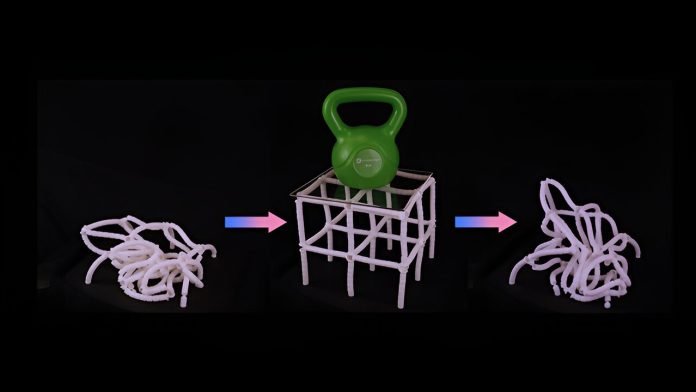
Inspired by vintage push puppet toys, engineers at UCLA have created a groundbreaking new material that can change its shape and stiffness, opening up exciting possibilities for use in soft robotics, reconfigurable structures, and even space engineering.
This innovative material mimics the inner workings of the toys, which can stand tall or collapse with a simple push of a button.
Push puppet toys are made of small pieces connected by cords. When the cords are pulled tight, the toy becomes stiff and stands upright.
But when the cords are loosened, the toy collapses and goes limp.
The UCLA team took this concept and applied it to a new type of metamaterial—a material that is specially engineered to have unique properties.
Their research, published in Materials Horizons, showcases a lightweight metamaterial that uses either motor-driven or self-actuating cords.
These cords are threaded through interlocking beads with cone-shaped tips. When the cords are tightened, the beads jam together and straighten into a stiff line, causing the material to become rigid while still keeping its overall shape.
One of the most impressive features of this new material is its tunability, meaning its stiffness can be adjusted based on how tight the cords are pulled. In its fully taut state, the material is at its strongest and stiffest.
However, by slightly loosening the cords, the material can flex while still remaining strong. This tunability is made possible by the precise geometry of the beads and the friction between them.
The material can also repeatedly collapse and stiffen, making it ideal for designs that require repeated movement. When not in use, the material can be stored in its limp state, making it easy to transport.
After being deployed, the material can become more than 35 times stiffer and change its damping capability by 50%. It can even be designed to self-actuate, meaning it can change shape on its own without human intervention.
“Our metamaterial enables new capabilities, showing great potential for its incorporation into robotics, reconfigurable structures, and space engineering,” said Wenzhong Yan, the lead author and postdoctoral scholar at UCLA’s Samueli School of Engineering.
For example, a soft robot made from this material could adjust the stiffness of its limbs to move more effectively over different terrains while still maintaining its overall structure. This sturdy material could also help the robot lift, push, or pull objects.
The researchers also see potential for other applications, such as self-assembling shelters that could unfold and take shape on their own or shock absorbers for vehicles that can adjust to rough environments.
“The general concept of contracting-cord metamaterials opens up intriguing possibilities on how to build mechanical intelligence into robots and other devices,” Yan added.
The study was conducted under the guidance of senior authors Ankur Mehta and Jonathan Hopkins, both professors at UCLA. Mehta leads the Laboratory for Embedded Machines and Ubiquitous Robots, while Hopkins heads UCLA’s Flexible Research Group.
They, along with their team, believe that by altering the size and shape of the beads or how they are connected, this material can be customized for a wide range of future applications.
This research marks a significant step forward in developing smart, adaptable materials that can be used in a variety of fields, from robotics to architecture to space exploration.
The possibilities are vast, and this new material could lead to innovative solutions for many challenges in engineering and technology.



